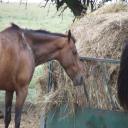Yahoo Answers is shutting down on May 4th, 2021 (Eastern Time) and beginning April 20th, 2021 (Eastern Time) the Yahoo Answers website will be in read-only mode. There will be no changes to other Yahoo properties or services, or your Yahoo account. You can find more information about the Yahoo Answers shutdown and how to download your data on this help page.
Trending News
Managing troubled hooves - to shoe or boot?
After a month of managing an abscess on what has a barefoot TB when I purchased him, he is finally sound and ready to start working. The dilemma is how to manage to foot, of which myself, my vet and my farrier and all have differing opinions. I had put shoes on the front prior to the abscess, so when the shoe was pulled, he was left with one on and on stall rest. He has graduated to a boot on the bare hoof and turn-out now that he's sound. The vet initially suggested leaving that hoof booted until the ground froze (it's fairly muddy here), then putting the shoe with a pad back on. The farrier agreed, but thought that considering the improved condition of the hoof, it would be acceptable to shoe/pad now. The most recent conversation with the vet was entirely different. He recommended investing a pair of riding boots (more rideable than the EZ Boot Trail he's wearing now) until spring. Here are my concerns: It's snowy/icy here in the winter, and I'm not thrilled about him not wearing studs. Considering the condition of his feet when I got him, barefoot is not an option. The foot that looks best at this point is the one that has the shoe. Also, he's a functional horse in training, and I'm not stoked about having a clunky boot on while attempting to teach him to move properly. That being said, I've never met anyone who has used a boot for anything other than trail riding, and I'm not convinced it as as much trouble as I think it is.
Has anyone had experience working in a boots? Is that really a more viable option than putting a show with pad on?
Good point re farrier v. vet on feet. My farrier has managed to keep all my horses sound for 13 years, so I think you're right on that one.
He came to me barefoot, and was a mess. He had holes where abscesses had been dug out previously, and was extremely flat-footed. His soles aren't very thick, and the argument from the vet was that he didn't think the hoof could manage shoe-trauma. I'm of a different (unprofessional) mind, as I'd rather get his feet off the ground, which seems to be paying off considering how to shod hoof looks. I won't let him go barefoot - I think no matter what the season and the footing, his feet just can't hold up to the terrain. Therefore, I would rather him have studs rather than a boot.
Barefoot: He was on stall rest after the abscess was opened. I then kept him wrapped when not treating the abscess. As explained above, his feet are in much better condition now, but where terrible. He has classic-TB, soft, poorly shaped hooves one of which has an gouge in it now.
6 Answers
- AngelaLv 610 years agoFavorite Answer
I think that since you have a very experienced farrier who you've found to be trustworthy, I'd take his advice over the vet's on this issue. After all, a farrier examines way more hooves in a day than the vet looks at in a month. Putting the shoe back on is certainly the less-hassle way for you to go. I think you are absolutely right in getting shoes on him to get those flat soles up off the ground and give him some protection.
But, I do think that a boot is a viable option if you wanted to try it. Not all boots are created equal though. I had a horse years ago who was given me for free partially because he had such lousy feet that nobody could keep shoes on him. The only shoes he could wear were $300+ glue-ons, which were driving me into the poorhouse! So I started using boots and they worked great. Horses cannot wear them 24/7, but my horse wore them for turnout every day (usually all day or all night depending on season) and for riding. I took them off every day in the stall to let his feet breathe and to prevent rubbing. This was a dressage and eventing horse, and we even went cross-country in his boots. Don't buy the Boa boots- they rub around the coronary band. Don't buy the old-fashioned Easyboots- they fall off constantly. My favorite are the Easyboot Epic with the neoprene gaiter. They never rubbed, never fell off, and were not clunky at all. I did look at the Old Mac boots but they looked more clunky and hard to put on. Putting the Easyboot Epic boots on takes only 4-5 minutes/day once you get used to it.
Source(s): Experience - swing lowLv 510 years ago
I do dressage in Renegade boots and while I waited for them to come (mail order took FOREVER) I used easy boots. My horse actually had better suspension and gaits in the boots than in shoes, leading to the boots being called "dancing shoes." After the initial week or so, they settle down and figure out that they don't have to move differently with boots than with shoes.
I don't know anyone who has left boots on all the time, including for turn out. Most of the boots are meant to be used only for riding. I have no idea whether the boots would rub to much if left on constantly (I'm thinking about the dirt that would get in between the heel and boots).
I'm also wondering whether you are thinking to take the one shoe off for the winter and go all barefoot or just use one shoe and one boot all winter-- I wouldn't recommend that. I think you would end up with some funny movement.
I'll also just say that there are arguments for barefoot over studs or boron in icy whether s well. Studs will cause your horse's leg to twist when they slip because they are only gripping in two areas. that can cause some pretty bad damage. Barefoot means more frog contact, which is basically like giving them a big piece of rubber on the bottom of their hoof--pretty good grip. My horse slips less barefoot than in shoes. If you are really concerned about not having studs, I think it is possible to put studs into some of the types of boots (not entirely sure, but I THINK I've seen that)
Basically, boots are definitely a viable option. Whether its a direction you want to go, or think that your horse's hooves could handle is entirely up to you.
- zakiitLv 710 years ago
I tried using boots on horses that had lost shoes and were waiting for the farrier. In my view, like you say, they are hopeless for helping the horse move correctly as they are so much bigger than the actual foot and on all of the horses that had them on we spent an inordinate amount of time searching for them in the paddocks because they would knock them off. A waste of time and money in my view. It was okay in a stable on box rest, though you could not get much of a poultice inside it.
I think if the farrier reckons that a shoe and pad is good, then I would go with that. Vets are brilliant at many things, but they are not farriers and as it is the farrier who sees most foot problems I would be inclined to follow his advice. He would not want to shoe or do anything to a horse unless it was in the horse's best interests.
Studs are not necessary.
- LilianLv 610 years ago
I would be puzzled as to why you would buy a horse that still had holes in his soles from previous abcesses, he may have something cronic in there that is not coming out when the abcess breaks. If he thought the abcess would break on the bottom of the sole why would he have taken off the shoe??
I have never used boots on a horse, I have made temporary boots out of heavy plastic that I could keep meds in and leave on.
A lot of the barefoot trimmers feel that going barefoot is one means of thickining the sole and letting it build up a thicker callous of the sole.
- How do you think about the answers? You can sign in to vote the answer.
- 10 years ago
I would put the shoe and pad on him. Boots are great if you're on the trail and you loose a shoe or if, as you found out, you're doctoring an abcess. However, if you're doing serious arena work and training with them a boot is clunky and gets in the way. I had an owner who refused to put shoes on their tenderfooted horse and I finally sent him home because he kept laming himself up because of the wires and clips cutting him.
- BarefoottrimmerLv 710 years ago
So why was the horse on stall rest? Did he wear a boot in the stall? What's the condition of his hooves? Sorry, this just seems to lack continuity. Why is it that he can't be barefoot???????What is so "troubling"?







